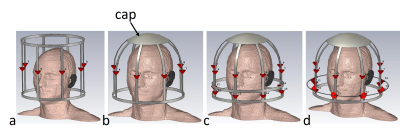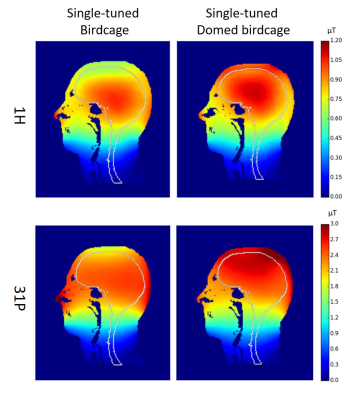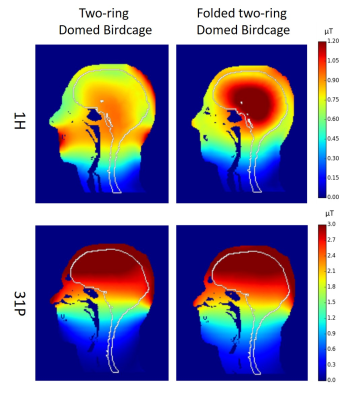4103
Numerical evaluation of a domed and folded two-ring birdcage coil for 1H/31P at 3T MRI1Institute of Neuroscience and Medicine 4, INM-4, Forschungszentrum Jülich, Jülich, Germany, 2Institute of Neuroscience and Medicine 11, INM-11, JARA, Forschungszentrum Jülich, Jülich, Germany, 3JARA - BRAIN - Translational Medicine, Aachen, Germany, 4Department of Neurology, RWTH Aachen University, Aachen, Germany
Synopsis
For double-frequency coils, it has been shown that four-ring birdcage coils provide minimum losses at X-nuclei frequencies. However, to avoid coupling between two rings, the length of the outer parts needs to be extended, increasing the unusable area at the service-end. In this study, we redesigned one side of the conventional birdcage coil as a dome shape by using end-caps. The domed birdcage coil was evaluated in simulations in both the single- and double-tuned condition. The performance of the folded-ring, domed and double-tuned birdcage coil was also evaluated and compared to that of a conventional single-tuned birdcage coil.
A four-ring birdcage coil has been used to investigate applications with non-proton nuclei (X-nuclei) since this design provides minimum losses at X-nuclei frequency. 1, 2 The inner-part of the four-ring birdcage coil is usually tuned to the X-nuclei frequency to maximise the efficiency of the X-nuclei signal, and the outer-part is tuned at the proton (1H) frequency. Due to coupling between the inner and outer rings, the outer-part of the coil needs to be considerably longer than the X-nuclei part, resulting in an increase in the unusable area at the service-end.
To improve sensitivity near the top of the brain, an end-cap design, which is detachable and can be connected to the legs of a birdcage coil, has been evaluated. 3, 4 In the case of connecting the leg to the end-cap, the end-ring on the service-end was replaced by an end-cap.
In this study, we modified the low-pass birdcage coil structure to a domed shape by connecting domed end-caps to the legs. The performance of the domed birdcage coil was evaluated by simulation and the results were compared to those of a single-tuned conventional birdcage coils. The use of the folded-ring 5 was also evaluated in terms of optimisation of the coupling between the inner and outer rings.
METHODS
To evaluate the performance of the proposed coil in comparison to the reference single-tuned conventional birdcage coil, a FIT simulation was conducted using CST. Fig. 1. shows simulation models of the single-tuned birdcage coil, and single- and double-tuned domed birdcage coils. The diameter and length of all coils were 27 cm and 24 cm, respectively. The domed birdcage coils were constructed by connecting legs to the domed end-cap, rather than the remaining the end-ring at the service-end, and the diameter of the dome was 27 cm. To generate a double-resonance, two-ring (Fig. 1c) and folded two-ring (Fig. 1d) domed birdcage coils were constructed. The inner and outer structures of the two-ring and folded two-ring domed birdcage coils were tuned to the 31P frequency (50 MHz) and to the 1H frequency (123 MHz), respectively. Fig. 2. shows the detailed structure of the folded two-ring domed birdcage coil. The diameter of the folded-ring was 32 cm. All coils were loaded with the DUKE mesh. The transmit efficiencies were calculated by dividing the B1+ field by square the root of the accepted power. The averaged values were calculated within the brain area.
RESULTS
Fig. 3. shows the transmit efficiencies generated by the single-tuned conventional birdcage coil and single-tuned domed birdcage coil at 1H and 31P frequencies. The averaged transmit efficiencies generated by all coils are summarised in Table 1. The single-tuned domed birdcage coil provided higher transmit efficiencies near the top of the head at both frequencies, as well as averaged values compared to the single-tuned conventional birdcage coil. Fig. 4. shows the transmit efficiencies generated by the double-tuned two-ring and folded two-ring domed birdcage coils. At the 1H frequency, the two-ring domed birdcage coil provided less transmit efficiency and shifted pattern than the single-tuned conventional birdcage coil due to coupling between the 1H and 31P rings, while the folded two-ring domed birdcage coil provided higher averaged transmit efficiency than the single-tuned conventional birdcage coil. At the 31P frequency, both the two-ring and folded two-ring domed birdcage coils provided 11% higher transmit efficiencies than the single-tuned conventional birdcage coil.
DISCUSSION
We proposed and demonstrated the use of a single- and double-tuned domed birdcage coils. The single-tuned domed birdcage coil provided higher transmit efficiencies than the single-tuned conventional birdcage coil at both the 1H and 31P frequencies. The single-tuned domed birdcage coil provided a higher filling factor and the end-cap structure improved the transmit efficiency near the top of the head. By connecting the end-cap, the end-ring on the service-end was closed so that the double-tuned structures were achieved by using two-rings instead of four-rings. At the 1H frequency, the two-ring domed birdcage coil showed a shifted transmit efficiency pattern to the patient-end due to coupling between 1H and 31P rings resulting in degradation of averaged efficiency in the brain, while the folded two-ring domed birdcage coil provided higher efficiency than single-tuned conventional birdcage coil. However, the focused pattern was relocated towards the centre of the brain by using the folded two-ring domed birdcage coil.
CONCLUSION
The domed birdcage coil was successfully evaluated both in single- and double-tuned operation. The folded two-ring was effective in terms of minimizing coupling between two end-rings. Since the domed birdcage coil provided higher averaged efficiency in the brain region than the single-tuned conventional birdcage coil for both single- and double-tuned operation, it is a good candidate for 1H/X-nuclei brain applications at 3T MRI.
Acknowledgements
No acknowledgement found.References
1. Y. Duan, B. S. Peterson, F. Liu, et al. Computational and experimental optimization of a double-tuned 1H/31P four-ring birdcage head coil for MRS at 3T. J. Magn. Reson. Imaging. 2009;21(1):13–22.
2. J. Murphyboesch, R. Srinivasan, L. Carvajal, and T. R. Brown. Two Configurations of the Four-Ring Birdcage Coil for 1H Imaging and 1H-Decoupled 31P Spectroscopy of the Human Head. Journal of Magnetic Resonance, Series B. 1994;103(2):103–114.
3. M. Alecci, C. M. Collins, J. Wilson, et al. Theoretical and experimental evaluation of detached endcaps for 3 T birdcage coils. Magn. Reson. Med. 2003;49(2):363–370.
4. A. Leroy‐Willig, L. Darrasse, J. Taquin, and M. Sauzade. The slotted cylinder: An efficient probe for NMR imaging. Magnetic Resonance in Medicine. 1985;2(1):20–28.
5. Y. Ha, C. Choi, W. A. Worthoff, et al. Design and use of a folded four-ring double-tuned birdcage coil for rat brain sodium imaging at 9.4 T. J. Magn. Reson. 2018;286:110–114.
Figures




